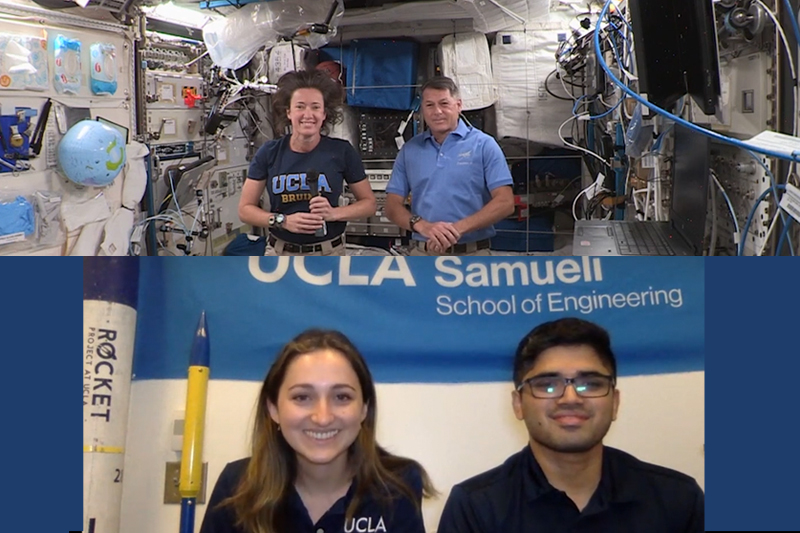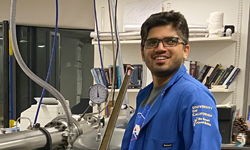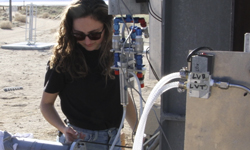UCLA Engineering In-Flight Conversation with SpaceX Crew 2 aboard the International Space Station

SpaceX Crew-2 mission pilot Megan McArthur ’93 and mission commander Shane “Kim” Kimbrough aboard the International Space Station (top) and Anneliese Peterson and Anil Nair at UCLA’s Laser Spectroscopy and Gas Dynamics Laboratory (bottom).
The SpaceX Crew Dragon spacecraft “Endeavour” carrying four astronauts from three countries successfully launched on April 23 from NASA’s Kennedy Space Center in Florida for a six-month mission aboard the International Space Station.
The 20-minute Skype interview by Anil Nair and Anneliese Peterson from UCLA’s Laser Spectroscopy and Gas Dynamics Laboratory was livestreamed on NASA TV. A recording showing the interaction between students at the UCLA Samueli School of Engineering and the crew aboard the International Space Station can be viewed in this YouTube video.
We followed up with Nair and Peterson post-interview to get their thoughts on the “out-of-this-world” experience.
Q: How do you feel about speaking with McArthur and Kimbrough, the pilot and the mission commander of SpaceX Crew 2 respectively?
Nair: I felt honored to have this unique opportunity to talk to Megan and Kim. Anneliese and I have both learned so much about space flight and travel in our classes, so it was great to hear about the astronauts’ experiences first-hand.
Q: Describe what it was like talking to people in space. How does it feel and sound differently or the same from calling someone on Earth?
Peterson: Talking to the astronauts in space felt surprisingly similar to a regular video call, except that there was a slight delay because they had to uplink our audio from the ground to the Station. I loved how Megan wore a UCLA shirt for the occasion!
Q: What came to mind when you first saw McArthur and Kimbrough?
Peterson: When their video first popped up on the screen — and I saw them floating in microgravity — I finally processed how unique the opportunity to speak directly with astronauts truly is. Their missions are so tightly scheduled that the fact that they took time to talk with us is incredibly generous, and we will remember this for the rest of our lives.
Q: What is the major takeaway from this interview?
Nair: The interview was very inspiring, and it made me excited to be a part of the amazing growth in the space industry that Kim mentioned! I look forward to developing rocket engine technologies to help send future astronauts into space.
Q: What is the one question you wish you had asked but didn’t get a chance to ask and why?
Nair: I wish I got to ask the astronauts what their favorite microgravity trick is, and if they could demonstrate it for us. It was really impressive to see them doing tricks like flipping upside down during the interview!
Q: Anything else you’d like to share with our audience?
Peterson: It was incredible to hear that our question about how to redesign the ISS had never been asked before. Now I know if I ever get to design a new Space Station in a future job, I should add more storage space!

Nair, a Ph.D. candidate in mechanical engineering and on his way to becoming a triple Bruin engineer, is currently doing research on detonation rocket engines and 3D-printed rocket engines. One of his goals is helping develop cutting-edge propulsion technology to enable future space travel. He served as Rocket Project president in his senior year and helped build the school’s first liquid-fueled rocket. In his free time, Nair enjoys playing bass guitar and running on the beautiful UCLA campus.

